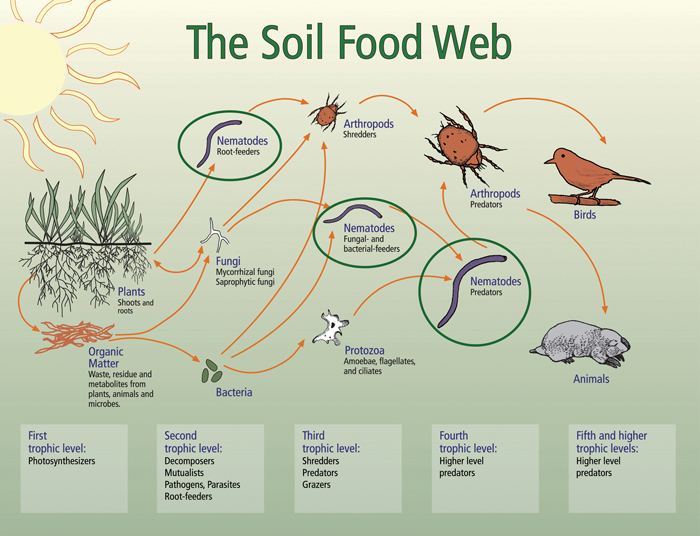
Integrated Pest
Management, North-West University and
Tropical and Subtropical Crops, Crop Protection, Agricultural Research Council
 Prof Driekie Fourie,
Prof Driekie Fourie,Integrated Pest
Management,
North-West University
 Dr Mieke Daneel,
Dr Mieke Daneel,Tropical and Subtropical Crops, Crop Protection, Agricultural Research Council
Soil is alive! In a teaspoon of healthy soil there are more organisms than people on earth. Bacteria, fungi, algae, protozoa and nematodes, among others, interact with the surrounding environment that consists of minerals, water, air, nutrients and organic matter. This collective of living and non-living matter represents the soil ecosystem.
Soil is dynamic! Energy is captured during photosynthesis by plants and flows through a complex and dynamic food web (Figure 1) to higher trophic levels. This soil food web also responds to both natural and human-induced changes and is sensitive to disturbance.
Soil is life! Without soil, life as we know it would not be possible. The services provided by soil ecosystems include food and fibre production, water quality and supply, carbon storage and pollutant degradation.
This article focuses on one of the most abundant and important multi-cellular organisms that forms part of the soil food web and the greater soil ecosystem, namely nematodes or aalwurms in Afrikaans. Different nematode groups, their function in soil ecosystems, how beneficial nematodes provide a service to producers and the use of nematodes as indicators of soil ecosystem health are discussed below.
Building and maintaining healthy, resilient soils
Nematodes are mostly known as pests that pose a major threat to crop production. This is as a result of the damage caused by specific plant-parasitic nematodes, for example, root-knot or lesion nematodes. However, the truth is that the majority of nematodes, both in terms of diversity and abundance, are beneficial and play a very important role in building and maintaining healthy, resilient soils. Beneficial nematodes are classified under different feeding groups that include, among others, bacterial feeders (Figure 2), fungal feeders, omnivores and predators (Figure 3). These feeding groups interact with each other as well as with other organisms that form part of the soil food web. They also fulfil multiple, indispensable ecosystem functions, including cycling nutrients, dispersing fungi and bacteria, decomposing organic matter, controlling pests, stimulating microbial growth and serving as a food source for larger soil organisms.

Nematode trophic (feeding) groups are encircled in green.
Credit: United States Department of Agriculture

Credit: Prof Joaquín Abolafia Cobaleda from the University of Jaén (Spain)

Credit: Dr Roy Neilson from the James Hutton Institute (United Kingdom)
But how does this benefit producers? In conventional agricultural systems, plants are largely dependent on fertilisers to meet their nutritional requirements. However, a healthy, functioning soil ecosystem can reduce the need for external inputs. Nematodes, for example, increase the availability of nutrients in a number of ways. By stimulating the growth and promoting the dispersion of bacteria and fungi, nematodes support the decomposition of organic matter and the release of nutrients. Furthermore, when feeding on bacteria, fungi and other soil organisms, nematodes excrete ammonium, a plant-available form of nitrogen. Scientific studies have shown that nematodes can increase available nitrogen in soil by more than 20%.
Nematode feeding also represents another important ecosystem function, namely pest control. By foraging on soil-borne disease pathogens, including plant-parasitic nematodes, pest populations are regulated or even suppressed. Another example of disease control is the use of entomopathogenic nematodes. These nematodes, in association with their symbiotic bacteria, parasitise and kill their hosts and are subsequently cultured in large numbers to be used as biocontrol agents for a wide variety of insect pests, including moths, flies, beetles and caterpillars. Also worth noting is the function of plant-parasitic nematodes. By grazing on roots (not excessively), nematodes can in fact stimulate plant growth.
It is clear that nematodes are at the service of producers. However, as nature would have it, beneficial nematodes are sensitive to environmental disturbances such as tillage and the use of pesticides – more so than plant-parasitic nematodes. Therefore, in order to benefit from the services provided by nematodes and functioning soil ecosystems, the drive towards sustainable agriculture and good agricultural practices needs to be continued. By limiting (or even eliminating) the physical disturbance of soil and using chemicals only when really necessary, producers can farm together with nature, rather than against it. It is also worth remembering that human activities are often responsible for creating environments favourable for pests. An example of this is a mono-cropping system with unhealthy soils where, for example, plant-parasitic nematodes can cause total crop failure. With the effects of climate change becoming increasingly evident, and with growing human populations, it is time to farm not for today, but for the future.
Measuring soil ecosystem health
Nematodes are not only great at helping us grow crops, they can also be used as a tool to monitor the progress in improving soil health. Since nematodes represent multiple feeding groups that form part of the soil food web, changes in the population numbers of one or more of these feeding groups (induced either naturally or by human activities) tell something about what is happening in the greater soil ecosystem.
For example, an increase in the number of mostly bacterial-feeding nematodes is indicative of soil enrichment. This would occur following the addition of mineral fertilisers or other nutrient-rich soil amendments such as manure or vermicast. Furthermore, the ratio between bacterial- and fungal-feeding nematodes suggests the energy flow (decomposition) pathway, either bacterial- or fungal-dominated.
While the former is typically indicative of an environment rich in nitrogen, the latter suggests increased availability of carbon. Also, omnivore and predator nematodes are generally the most sensitive to disturbances like tillage. Therefore, if these nematodes occur in low numbers or are absent, it shows that the system is unhealthy and not functioning optimally.
Although these statements may seem arbitrary, scientists have developed a set of indices, known as nematode-specific indices, that allows accurate comparisons between fields/treatments, as well as soil ecosystem health monitoring. Typically, soil samples are collected after which the nematodes are extracted, identified and counted by trained personnel using microscopes (nematodes are very small). The generated data are then used to calculate selected nematode-specific indices.
Two sets of these indices that are useful for measuring soil ecosystem health in agricultural systems, will be discussed briefly. The first is the Maturity Index, which ranges on a scale from 1 (disturbed) to 5 (stable). This index makes for quick and easy assessments and comparisons between sites. In a conventional agricultural system, one expects to find low Maturity Index values. However, in a system where soil health is promoted, the Maturity Index value should increase over time as the soil ecosystem recovers.
A second measure of interest is the Soil Faunal Profile (Figure 4). As seen in Figure 4, this profile consists of a graph with the Enrichment Index representing the y-axis and the Structure Index representing the x-axis. The Enrichment Index serves as a measure of nutrient availability, while the Structure Index indicates whether the soil food web is functioning optimally. By calculating these two indices, a field or site can be plotted on this profile and the soil food web status determined. For example, a field that plots in the left lower quadrat is classified as degraded and depleted, while a field that plots in the right upper quadrat is classified as maturing and N-enriched. For producers that aim to farm more sustainably and/or implement conservation agriculture systems, the goal should be to plot in the right lower quadrat, thus having mature and fertile fields. The Soil Faunal Profile is an overall measure of soil enrichment and ecosystem health.

Throughout history, nematodes have often been scrutinised for the role that the minority plays in crop loss. Isn’t it time that credit is given to the majority for services rendered?
The Nematode Diagnostic Laboratory of the North-West University provides a soil ecosystem health assessment service to producers and other interested parties. Please contact Dr Gerhard du Preez (gerhard.dupreez@nwu.ac.za) or Prof Driekie Fourie (driekie.fourie@nwu.ac.za or 018 285 3006) for further information.


















